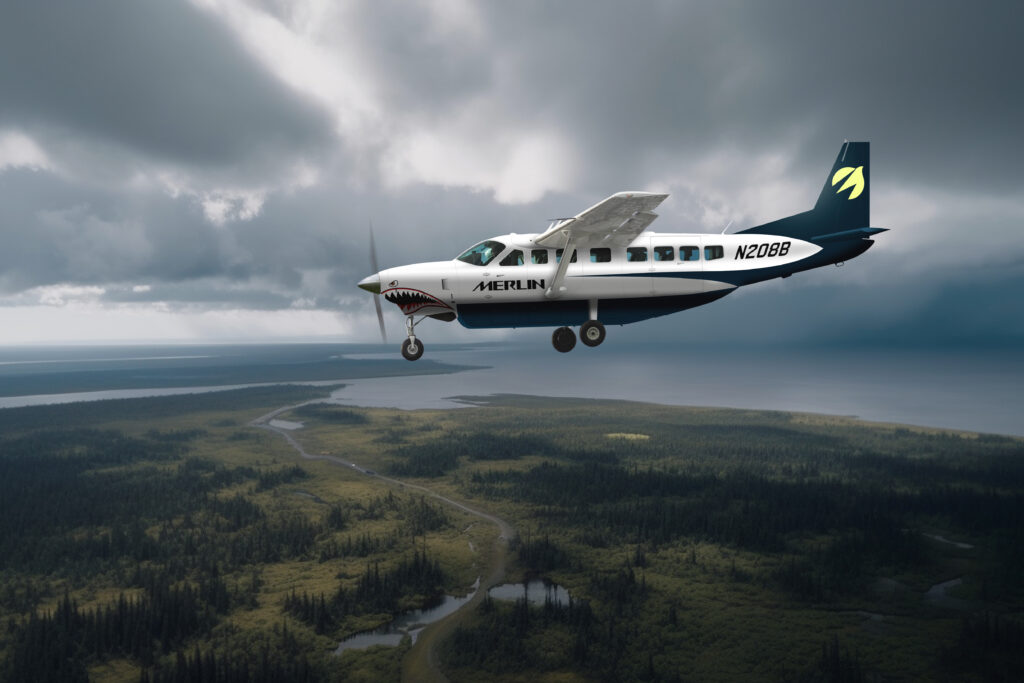
The new Chief Policy Officer at Merlin, Travis Mason, discusses the need to reimagine and reshape aviation rules for the integration of new technologies; the importance of the human-technology relationship in the flight deck; and upcoming regulatory progress. (Photos: Merlin)
As the aviation industry continues to evolve, the rules governing flight operations must adapt to accommodate the emergence of cutting-edge technologies and innovative business models. In an interview with Merlin’s new Chief Policy Officer, Travis Mason, we delve into the world of autonomous flight and the critical role policy-making plays in this rapidly changing landscape. Mason also shares his perspective on the vital relationship between humans and technology in the flight deck.
Merlin develops autonomous flight technology for fixed-wing aircraft that works in tandem with national airspace systems and a human safety pilot onboard the aircraft. The company’s strategy includes three phases: first, its team will work with New Zealand’s Civil Aviation Authority and the FAA to certify its technology and integrate it into commercial flights in New Zealand. Second, it hopes to reduce crews on large commercial cargo aircraft. Third, Merlin plans to enable flights for large aircraft with reduced crews and to enable uncrewed flights for small aircraft.
From challenging existing regulations to shaping a safer and more sustainable future for aviation, Merlin intends to play a key role in transforming the industry. Check out our question-and-answer session with Mason below.

Travis Mason, pictured above, will lead a team of certification, compliance, and engineering experts in the certification process of the autonomous technology developed by Merlin.
Avionics: What brought you to the Chief Policy Officer role at Merlin?
Travis Mason: I love making rules when old ones no longer work. Aviation is one of those places where old rules need to be reimagined in order for new technologies and new business models to take shape—and to put us in a place where we have a safer, more eco-friendly, more resilient product in aviation. What drew me to Merlin is I get to help change the rules for the future of aviation and help reshape those rules for new technologies.
What are some of your priorities as CPO?
My first priority is to lead the team that I’m in charge of well. I lead a team of regulatory experts and engineers that are charged with certifying our technology, ensuring that it meets—and in some respects exceeds—the safety standards set by regulators. My first role is ensuring that the folks I work with are listened to and that together we shape the vision for the company.
One of the things that you can see us leaning into is this notion of better enabling a relationship between humans and the machines that they use in the flight deck. Since the dawn of the jet age, technology has been maturing alongside the growth of aviation. Really the only way that we scale these future visions in aviation is to get the human-technology relationship better and better. It’s something that we’re dealing with today in aviation, and it’s one of the greatest challenges that we have moving forward, as more automation and new technologies enter the flight deck.
One of the priorities for our team is creating a vision and creating a focus in those areas so that it can enable what we’re building to be safer for the flight deck and safer for the skies. It also helps to enable us to get through the certification efforts that we’re undertaking in a more streamlined way—as we think about how this technology engages with the humans in the flight deck and the humans who are working on traffic management throughout the national airspace.
How do you see the industry evolving over the next five years?
I think in the next five years, you’ll see even more interest in this space. We know that there are many issues the industry is facing: everything from environmental sustainability to pilot shortage. One of the issues is this notion of teaming between our pilots and the increased technology that they are meeting in the fight deck. This is not just an issue for aviation; it’s an issue for manufacturing, health care, [and] in finance as automation and AI enter those spaces.
Figuring out how we as humans collaborate with this technology is going to be super important so that we lean in to our strengths and the technology. We have a better product that way. In some cases, particularly in aviation, we can create a safer network, but that assumes that we’ve done the homework of getting that relationship to a better place.
Is there anything you can share about upcoming milestones or objectives for the next year or so that we might expect to see from Merlin?
Pretty soon, we will announce more about what’s going on from a certification perspective of the programs underway with regulators in New Zealand and verification with the FAA. You’ll hear us talk more about how that activity is going. You’ll also hear us talk about how this activity relates to other efforts we may pursue in the near future this year. We’ll have more updates very soon on our regulatory progress, and in particular, how our certification program is going in New Zealand.